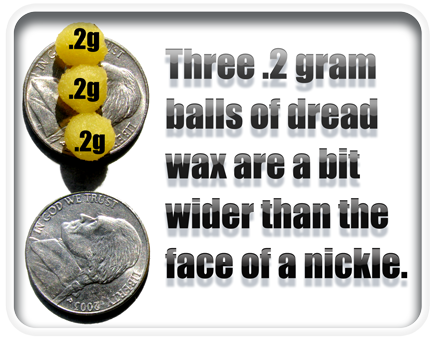Maintenance Waxing
Adding wax after your dreadlocks are in.

First I'll give you some maintenance waxing guidelines and then we'll talk about how much wax to use for a maintenance serving....
Maintenance Waxing Guidelines
- Check to see if you can feel dread wax in or on the dread before you wax. Do not wax dreads that already have a detectable amount of dread wax in them. By waiting until the dread wax is gone before adding more it's easy to avoid over waxing. Some dreads may need it while others don't and it's fine to only wax some of 'em.
- Always work wax in completely as you add it, 3" at a time, rather than gooping it on and then trying to work it in all at once.
- Always warm it up and smooth it between your fingers before adding it.
- Always palmroll each dread for 1 minute after adding dread wax. This allows the dread to get the full benefit of the wax and it removes excess wax from the surface of the dread while helping the new dread wax work in.
- Always warm the dread with a hair dyer after waxing. If wax is visible on the surface of the dread while it's melting in use a paper towel to absorb it from the surface.
- Always wax dry dreads rather than wet dreads.
- Always remove wax with a "hot rinse" at the end of each month.
- Always stop waxing when the dreads lock up.
Dread Wax Maintenance Serving
After your dreads are in you'll be using the maintenance serving of wax rather than the initial serving. The only time you might use the initial serving again is if you need to comb out and restart one of your dreads.
There are two maintenance serving sizes, one for lil dreads and one for big dreads, just as with the Initial Serving. This amount is per every 3" of dread. This means if the dread is six inches long you apply the maintenance serving two times, once for the first 3" and again for the second 3".
- Small Dreads that are between .5cm (one fifth of an inch) and 2cm (four fifths of an inch) get .2 grams of wax per 3".
- Larger Dreads that are 2cm or larger get .4 grams per 3"

This isn't the most accurate way to measure your balls but it will get you much closer than guessing... Of course the closer your balls are to round the better this method will work. =] ...Stop being dirty.
When to wax during the first month.
During the first month you want to have a small amount of wax in the dreads all the time. This doesn't mean that it's an emergency if you can't feel wax in them. It just means that if you can't detect any wax in them you should add some next chance you get. If you're about to wash them tomorrow don't add wax today...instead wait until after you've washed them and taken care of loose hair (creating knots)...then when your knot making maintenance is done add a little wax to the dreadlocks that need it and palm roll.
You'll palm roll each dread for one minute when you add the wax. Then each day that you can feel wax in the dread you should try to palm roll each dreadlock for 30 seconds. You prolly won't have time to sit down and do them all at once. Maybe palm roll the ones in the front in the morning, the ones on the top after lunch and the ones in the back while you're watching tv at night. You don't have to do it but it will make a big difference if you do. This is just for the first month by the way, not for the life of the dreads. =]
The Hot Rinse.
The second month you're going to switch this up. Instead of having wax in them all the time you'll only use it every other week. At the end of the first month you'll do a "Hot Rinse" which will remove the wax from your dreads in preparation to make knots. This is a two part process:
- Part 1: Heat each dread with a hair dryer. The wax will literally liquefy, just as it does when you have just added it and you are melting it in and removing any extra. While it's hot, squeeze the dread with a paper towel to absorb any wax. If you have very little wax in the dreads this step may not even be necessary.
- Part 2: This is a double washing with extra dread soap and nice, hot water.
This two part Hot Rinse removes the wax from the dreads and is an important part of creating the knot making environment for your first "A" Week. We'll talk a lot more about why this is done in the next section. The very first hot rinse is the most important because you'll have more wax in the dreads during the first month than all future months combined.
One popular anti-wax rumor is that wax stays in your dreads forever. This probably got started because dread wax is difficult to remove if you don't know how. Castile soaps or non-soaps like baking soda don't do a very good job of cleaning wax. Even DreadHead Dread Soap - which is made to remove the wax - takes multiple washings. Having extra wax increases the amount of washing needed. There is good news though...
DreadHead wax is especially sensitive to heat. It has been designed to turn into a liquid with the heat from a regular hair dryer. As you can imagine this greatly simplifies wax removal. All you have to do is heat each dread with a hair dryer and squeeze it with a paper towel while it's hot. The liquid wax will come right out. After the majority of the wax has been removed this way it's much easier to wash out any remaining wax with hot water and dread soap. Our dread soap is extremely efficient and does an excellent job of removing the remaining wax.
The hot rinse at the end of the first month marks your transition to the A-B Maintenance routine - The fastest way to lock your dreads up since ever... You'll learn how to use the A-B routine to give your knots just what they need in the next section.
Wax until tight.
As important as knowing when to wax is knowing when you're done with wax. In short, wax is a tool for helping the knots in your dreads compress and tighten. When your dreads have reached your desired tightness you no longer need to apply dread wax. If you're palm rolling very consistently and your hair is dense, fine and in medium or large sections your dreads may reach your desired tightness in as little as a month.
The initial application of dread wax is the most important. It will bring the puffy loose knots in close to each other so they can begin to find their place in the dread. This will allow the dread to tighten with many less loops and zig-zags. The core of most peoples dreads reach desired tightness around the second month. As your dreads get closer to this point you'll be following the A-B Maintenance routine and using almost no wax at all.
As you feel the "core" of the dread becoming tight the wax has done it's job and it's ready to be removed with a hot rinse. Waiting longer or adding more wax after the core has tightened will make wax removal more difficult and it won't offer you any benefits. It's always possible to remove our wax -and if you need any help I'll be glad to walk you through it - but it's easier to keep an eye on their tightness and remove the wax as the core tightens rather than after.
In the past dread wax was also used to moisturize dreads since it didn't cause them to slip apart or loosen as many moisturizers do. While it can be used as a moisturizer, if it's used carefully, there are a few reason it's no longer recommended. First, it's much heavier and harder to use than alternatives like Dread Butta or Dread-Licious. Second, dread wax feels waxy until it's worked into the dread, and it's meant to do it's job from the inside of the dread. Dread Butta is meant to be used on the surface of the dread and it makes your dreads feel soft and fun to touch. Third, it's more difficult to remove wax from a mature dread, especially if it's over-applied. Dread Butta and Dread-Licious on the other hand, are much lighter products that are designed to wash away in every shower.
Most serious hair damage occurs in dry, brittle hair. Dreadlocks are unique in that the same hair is always on the surface, exposed to physical stresses like rubbing or scratching, chemical stress like bleaches or dyes, UV damage from the sun, etc. By using a moisturizer regularly you can keep the hair moisturized so it can stand up to this abuse without breakage.

